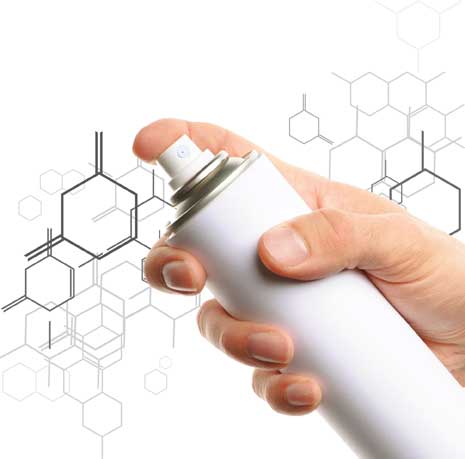A compressed gas spray duster, otherwise known as an ‘airduster’, has a wide variety of uses in many different areas of industry and at home. Airdusters effectively offer a quick solution to remove any airborne contamination from areas of electrical and electronic equipment that are either too fragile to be manually cleaned or too difficult to reach.
You might be under the impression that an air duster is simply a can of compressed air but this is absolutely not the case. In the majority of airdusters, propellants are used to ensure a longer spray life and it is the choice of propellants that have driven a plethora of different aerosol technologies over the years.
The earliest airdusters used chlorofluorocarbons (CFCs) - non-flammable propellants that delivered good performance, but harmful depleting effects upon the earth’s ozone layer. Indeed, massive depletions were observed over Antarctica, and in 1989 the Montreal Protocol was finally declared. This is an international treaty set up to protect the ozone layer by phasing out the production and use of CFCs, as well as other substances that were identified at the time as being responsible for ozone depletion. Work on alternatives was already underway in the 1970s when ozone damage was first observed. These included hydrochlorofluorocarbons (HCFCs), and chlorine-free hydrofluorocarbons (HFCs) - most notably HFC-134a. Since this time, HFCs have been the leading propellant used in airdusters with butane and other organic gases also being used.
In recent years, however, as Europe and the rest of the world are starting to tackle more of the goals put forward in legislation, HFCs are now becoming a target for phase-out. The main legislation in throughout Europe focusing on the issue is Regulation EC No 846/2006. It has severely limited the usage of HFCs, while an outright ban has existed for its use as a refrigerant in car air conditioning equipment since 2011. Further changes to the legislation include EU No 517.2014, which came into full force on January 1st 2015. Regulation EC 846/2006 was subsequently repealed, to be replaced with much wider reaching legislation, the goal of which is to cut HFC use to one fifth of 2014 levels by 2030.
Along with these new overall legislations being brought to bear in the EU and indeed the world as a whole, there are countries that are also imposing taxes on the use of HFCs. Denmark was the first to bring such a tax in place in 2001, with Norway following on quickly in 2003. Since then, Slovenia and Spain have also begun taxation on the import and usage of fluorinated gases. Beyond Europe, there are levies against the use of fluorinated gases being considered and raised in Canada, New Zealand and Japan.
|
Country |
Tax imposed on HFC-134a per tCO2eq (€)1 |
|
Norway |
55.3 |
|
Denmark |
28.8 |
|
Slovenia2 |
3.7 |
|
Spain3 |
26/22. |
|
1)All tax information has been found on http://www.r744.com |
|
Global Warming
The increased taxation and imminent removal of HFC-134a and other gases as refrigerants and as propellants for air dusters and other aerosols in general has prompted manufacturers to look for alternatives. However, there is another hurdle to overcome once this legislation is brought into effect – that the maximum global warming potential (GWP) of a propellant is not greater than 150. This is due to take effect on January 1st 2018, and indicators are that it will be reduced further in the future.
GWP is a relative measure of how much heat a greenhouse gas traps in the atmosphere. It compares the amount of heat trapped by a given mass of the greenhouse gas –HFC-134a, for example - to the amount of heat trapped by a similar mass of carbon dioxide (which is standardised as having a GWP of 1). The GWP of HFC-134a is as much as 1,300 times that of carbon dioxide. In short this means that your current airduster utilising HFC-134a will no longer be manufactured after January 1st 2018.

The gradual phasing out of HFC-134a as a viable propellant for airdusters has sparked a demand for alternatives. Electrolube has led the field to produce a unique alternative technology for its range of airdusters. The company considered several alternatives during the developmental process including Hydrofluoroolefins (HFOs) - specifically HFO-1234ze. Initial reactions were positive and the propellant considered a viable alternative but this was quickly tempered by the prohibitive cost of the gas. Electrolube quickly realised that a HFO gas filled airduster would not offer a sufficiently competitive price point when compared directly to the existing HFC products.
The technology that was finally decided upon for Electrolube’s new Air Duster Zero™ product makes innovative use of an activated carbon absorbent material. As an alternative to traditional aerosol propellants such as flammable hydrocarbons and environmentally damaging HFCs, the completely non-toxic and odourless Air Duster Zero uses recycled carbon dioxide to offer a number of other environmental and health & safety advantages, such as no reduction in indoor air quality.
Air Duster Zero™ is a non-flammable and invertible airduster with a GWP of just 1. It has zero odour and most importantly can promise zero harm to the atmosphere (no noticeable effect upon the ozone layer) thereby meeting all the requirements of the Montreal protocol.
Development Issues
Flammability was a key consideration in the development of the Air Duster Zero’s propellant technology, particularly as it might be needed to clean live equipment. The use of a flammable propellant such as butane was simply not viable as the smallest spark from live equipment could literally turn an airduster into a mini flamethrower. While this critical safety consideration narrowed the field of choice considerably, the Air Duster Zero™ neatly sidesteps the problem by using a non-flammable gas: namely, carbon dioxide.
The last hurdle to overcome during the development of Air duster Zero was to get the end user price point right. Electrolube sought to develop a product that could be dropped into the catalogue with a similar price tag in order to minimise any disruption the ban of HFC-134a might have on supply chains. With the high energy cost associated with the manufacture of HFOs, it was decided that HFO-1234ze was not an option as it would be considered too expensive to offer as a viable drop-in alternative to the current non-flammable products.
Today, the Air Duster Zero™ and its novel approach to dispensing recycled, inert CO2 gas provides not only a safe and sustainable solution for users of technical airdusters, but one in which they can be confident will comply with all current and future legislation
Author: Jade Bridges - Electrolube. Original Article here



